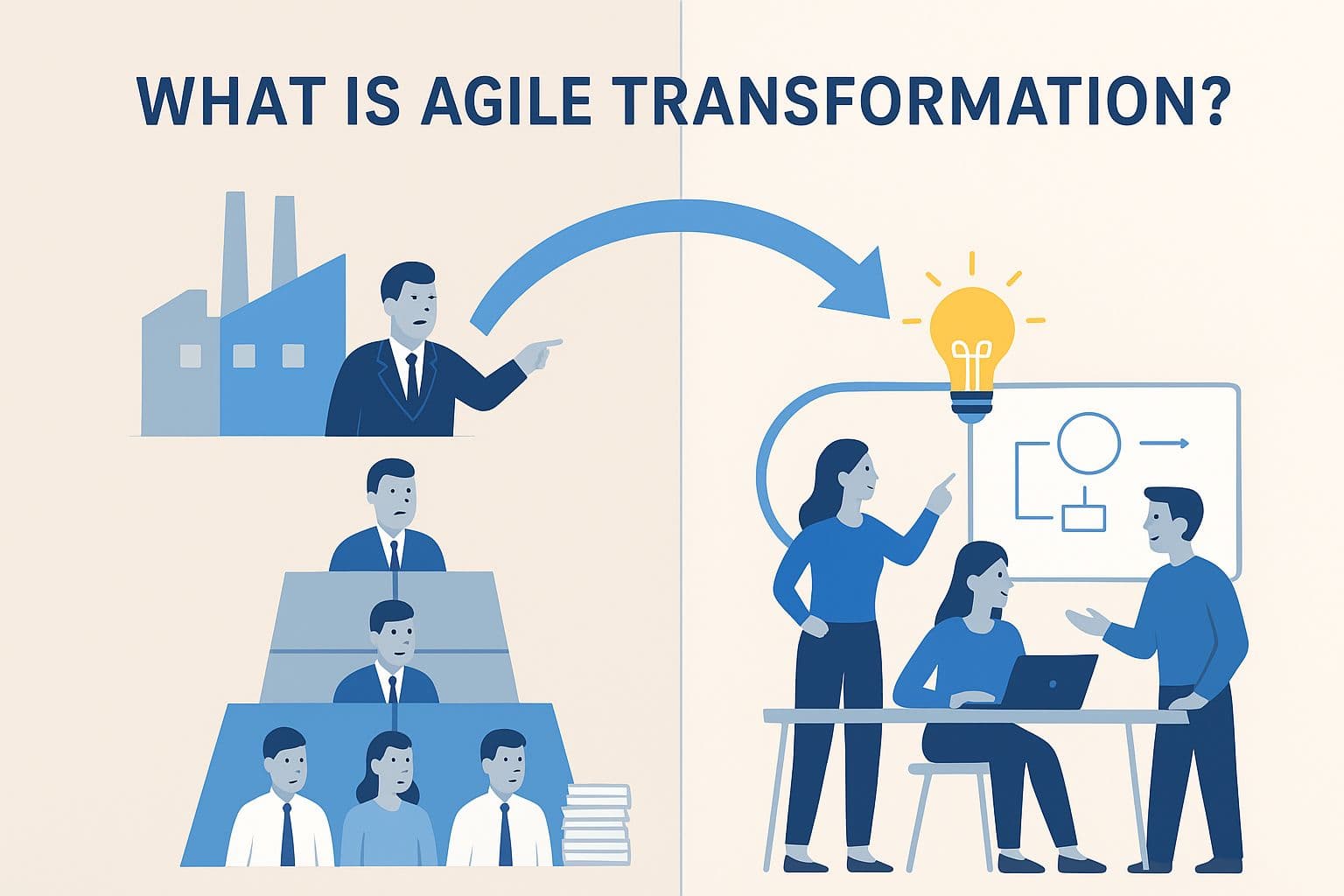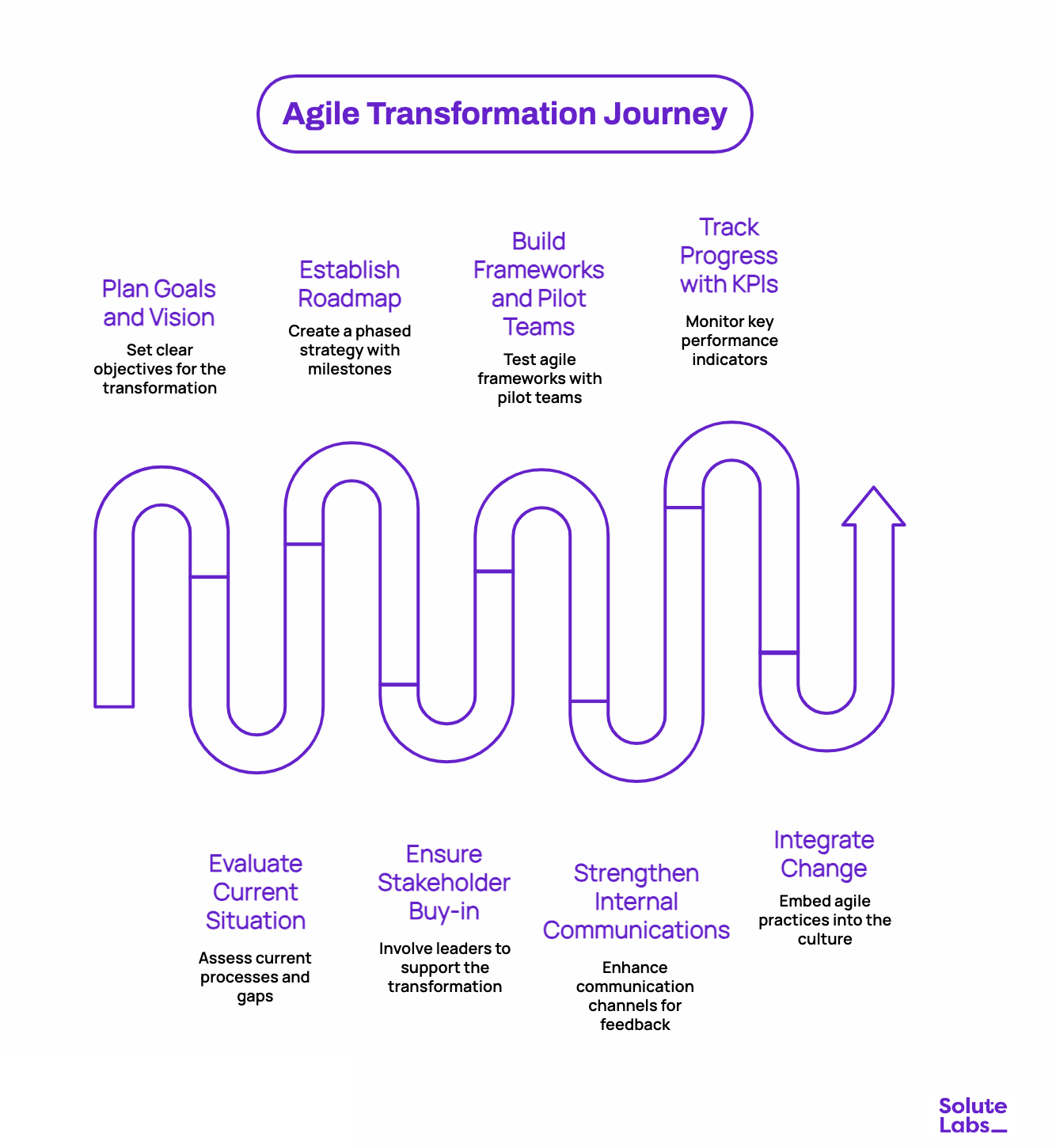Agile Transformation transcends being only a fashionable term used by consultants and agencies. In the contemporary corporate environment, almost every firm underscores the need to start an Agile transformation journey; nevertheless, only a select few can explicitly articulate its significance for them or delineate a definitive strategy for its attainment.
Recent research indicates that 47% of organizations see enhanced time-to-market after the use of Agile techniques.
In this blog, we will look at the core concept of Agile Transformation, its significance, and the strategic approach to navigating it. We will also examine the reasons behind the failure of several Agile Transformations, identify the primary problems encountered by businesses, and provide practical recommendations for ensuring your transformation's success.
You'll discover what capabilities are needed, who can support you in the process, and finally we will answer the question you have been asking: how do you successfully lead an agile transformation!!
So, without any further ado, let's get started! Begin!
Overview of Agile Transformation

An Agile Transformation entails transitioning from an organization that responds sluggishly to market fluctuations to one that can swiftly adapt, perpetually innovate, and capitalize on opportunities more rapidly than its rivals. For the majority of firms we have worked with, this transition goes beyond just adopting Agile techniques; it entails evolving into an organization that is robust, adaptable, and perpetually prepared for future challenges.
Historically, several firms have excelled at optimizing their established business models, such as automobile makers that refined the internal combustion engine over decades. However, in the realm of innovation concerning new goods (such as electric automobiles) or wholly novel business models (like ride-sharing), they have difficulties in maintaining momentum. Enterprise agile transformation helps firms in transitioning from safeguarding the traditional to adopting the innovative.
Obstacles often reside in entrenched frameworks: several management tiers that foster bureaucracy, inflexible regulations, and performance measures that incentivize stability over innovation. These mechanisms may protect the existing "cash cow" while hindering the development of new ones. Moreover, they often endorse CEOs adept at preserving the status quo, rather than cultivating the entrepreneurial attitude essential for generating long-term shareholder value.
An authentic agile transformation reconfigures both processes and culture. It necessitates dismantling silos, reevaluating hierarchies, and enhancing internal communications in agile transformation to enable individuals at all levels to assume ownership, engage in experimentation, and instigate change. Ultimately, it involves establishing an organization capable of continual reinvention.
Why Should Enterprises Go Through an Agile Transformation Journey?
VUCA stands for volatility, uncertainty, complexity, and ambiguity. This means that the market is always changing, so businesses can't stick to their rules for decades. They need to change how they do things to get around business roadblocks and stay useful and relevant. Here are the primary explanations for why an organization needs to change to an agile way of working:
- Changing Market Conditions: In today's fast-paced business world, companies need to be able to respond quickly and effectively to changes. Agile methods give you a way to adapt to changing market conditions and customer needs by encouraging regular reflection, faster release cycles, shorter feedback loops, and shorter development cycles.
- Better Alignment with Business Goals: Agile methods encourage a focus on meeting customer needs and aligning with business goals. This can help companies reach their strategic goals more easily.
- Great Customer Satisfaction: Businesses are under more and more pressure to offer goods and services that make customers happy. Customers have higher expectations because businesses' products quickly become out of date after they are offered. In this fast-paced world, agile methods help companies make goods and services that meet their customers' needs by putting a lot of emphasis on customer feedback and participation.
- More Cooperation: As businesses get more complicated because of changing needs, new technologies, and employees who work from different places, they need to work together and talk to each other better in departments and teams. Agile methods help people from different departments work together and communicate better, which helps everyone get on the same page and solve problems faster.
- Better Quality: To stay competitive in today's market, companies must offer goods and services of high quality. Agile methods promote ongoing testing and development, which helps businesses deliver high-quality goods and services. Getting quality assurance teams involved early on and throughout the development process helps find product flaws and fix them faster, which leads to high-quality products.
- Shortening the Feedback Loop: Agile methods encourage teams to regularly deliver smaller, working pieces of software. This can help them check that the product's goals are being met and make any changes that are needed.
- Faster Value Realization: Incremental delivery lets businesses cut down on development time and launch goods and services faster, which means they can give customers value faster.
Step-by-Step Process for Your Agile Transformation Journey

Agile transformation is a structural and cultural change that calls for strong leadership, clarity, and consistency. It is not only about implementing new frameworks. Organizations can create agility that endures by using a well-defined agile transformation roadmap, backed by organized agile transformation steps, efficient internal communications in agile transformation, quantifiable agile transformation metrics KPIs, and strong agile transformation change management. The following actions should be taken into consideration while embarking on your Agile transformation journey:
1. Plan Your Goals and Vision
Set the goal of your agile transformation first. What business issues are we resolving, you ask? Which results are more important: increased innovation, quicker delivery, or higher customer satisfaction? Establishing this goal gives the entire organization a common goal.
2. Evaluate the Present Situation and Any Gaps
Assess the current state of your organization's procedures, culture, team development, and leadership alignment. Knowing your current advantages and disadvantages guarantees that your transformation strategy is customized rather than universal.
3. Establish the Roadmap for Agile Transformation
Create a phased strategy including timetables, pilot projects, and milestones. The agile transformation roadmap guarantees that teams and leadership are headed in the same direction and offers an organized method of prioritizing projects.
4. Ensure Stakeholder Buy-in and Leadership
Agile projects frequently fail if they are not supported by the leadership. Involve department heads and executives early on, making sure they promote teamwork, set an example of agile conduct, and remove obstacles.
5. Build Frameworks and Pilot Teams
Start with small, interdisciplinary pilot groups that test out agile frameworks such as Scrum or Kanban. These pilots act as test sites, producing early successes that boost the organization's confidence and momentum.
6. Make Internal Communications Stronger
The foundation of agile is open and honest communication. Use open forums, stand-ups, and town halls to establish feedback loops. In agile transformation, effective internal communications ensure that staff members see the progress, comprehend the "why," and feel part of the process.
7. Use KPIs and Metrics to Track Progress
Agility needs to produce quantifiable outcomes. Establish and monitor key performance indicators (KPIs) for agile transformation, including team morale, customer happiness, product quality, and delivery cycle time. Along the process, these indicators assist leaders in making data-driven decisions and improving their tactics.
8. Integrate Change Using Culture and Management Practices
Maintenance of change after its first implementation is necessary for true transformation. Organizations may ensure agility gets ingrained in the company's DNA by using structured agile transformation change management to reinforce new behaviors through coaching, training, recognition, and continuous improvement activities.
The Goals of Agile Transformation
The main purpose of agile transformation is simple: to enable businesses to work in a way that feels more natural, less rigid, and far more open to change. The focus is no longer on getting mired in protracted planning cycles or layers of approvals. Instead, it's on giving teams the power to provide value rapidly and learn as they go. It's about making a place where decisions are based on what customers want and teams can alter when things change.
Agile transformation goals not only speeds up delivery, but it also makes work more meaningful because workers can see how their labor affects others. This is also about altering the way people work together. It's about getting people to trust each other, breaking down barriers, and having open conversations so that everyone feels heard and involved. The idea is to build teams who aren't scared to try new things, learn from their errors, and keep getting better without worrying about failing. It's not so much about "doing agile" as a checklist as it is about "being agile" as a way of thinking. This keeps the organization strong, creative, and ready for everything that comes next.
Agile Transformation Operating Model
McKinsey says that agile transformation affects five primary parts of a business: strategy, structure, people, process, and technology. While it's crucial to look at all of these things, a lot of companies don't pay enough attention to the "people" part of agile transformation.
Because of this, hurdles are put up very early on in the process, which makes failure unavoidable. Everything else is a lot easier if your staff are on board with your new culture and initiatives.
Common Barriers in Agile Transformation
Moving toward agile isn’t as straightforward as it may sound. Every organization faces its own roadblocks, but a few challenges tend to come up more often than others.
Resistance to change – People are naturally wary of new ways of working. It takes consistent effort from leaders to show employees why agility matters and how it can make their work easier and more rewarding.
Lack of leadership backing – Even if teams are on board, things won’t move forward without support from managers and decision-makers. Leaders set the tone, and their commitment is what keeps the momentum alive.
Weak communication – Many transformations fail simply because updates aren’t shared clearly or at the right time. For change to stick, communication needs to be open, ongoing, and tailored to different teams.
Limited tools and technology – Agility isn’t just about mindset; it’s also about having the right systems in place. Without modern tools, collaboration and fast delivery become much harder.
What Drives a Successful Agile Transformation?
The outcome of any transformation depends on a few essentials. These agile transformation success factors often make the difference between progress and frustration:
- Leaders who don’t just talk about agility but actively model it.
- A vision that gives teams direction and clarity.
- Early involvement of employees to build trust and ownership.
- Honest, transparent communication that keeps everyone aligned.
- Tools that allow teams to work smarter and faster.
- A culture of learning where feedback and training never stop.
How SoluteLabs Can Support Your Agile Transformation?
At SoluteLabs, we don’t believe in one-size-fits-all playbooks. Our agile transformation consulting services are designed around the unique needs of your business. Whether it’s defining the roadmap, choosing the right tools, or guiding teams through the change, we focus on making agility practical and impactful.
We also help organizations establish an agile centre of excellence (CoE)—a dedicated hub that nurtures collaboration, drives innovation, and ensures agility becomes part of your company’s DNA. By bringing leaders, teams, and technology together, we make sure your transformation isn’t just a phase but a lasting shift.
The Bottom Line
Agile isn’t a checklist to complete, it’s a mindset that reshapes how a business operates. Companies that embrace it find themselves more flexible, resilient, and customer-focused. A strong product operating model agile framework makes sure this mindset runs deep across the organization.
If you’re ready to move beyond theory and bring agility to life in your business, SoluteLabs can help. Contact us today and let’s talk about how we can walk this journey with you.







